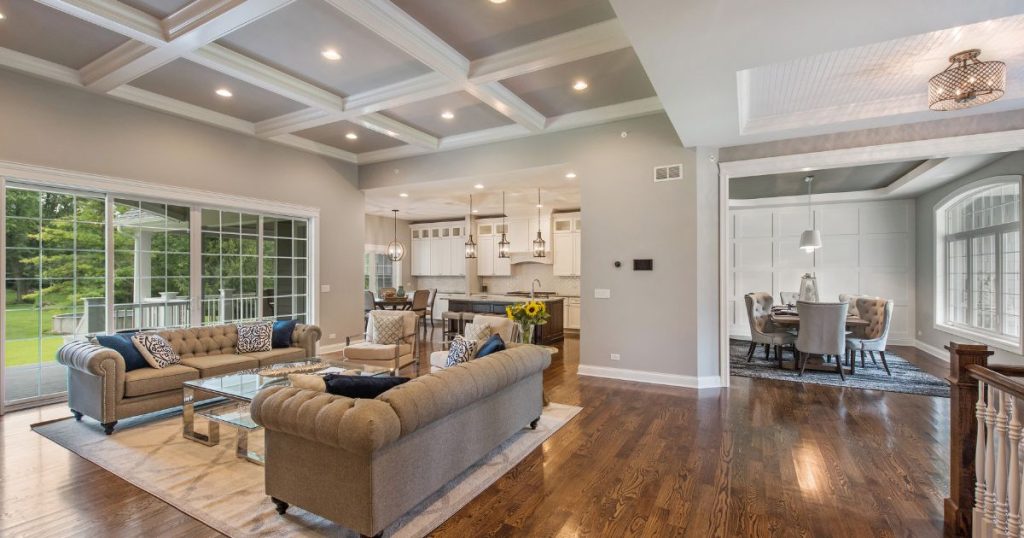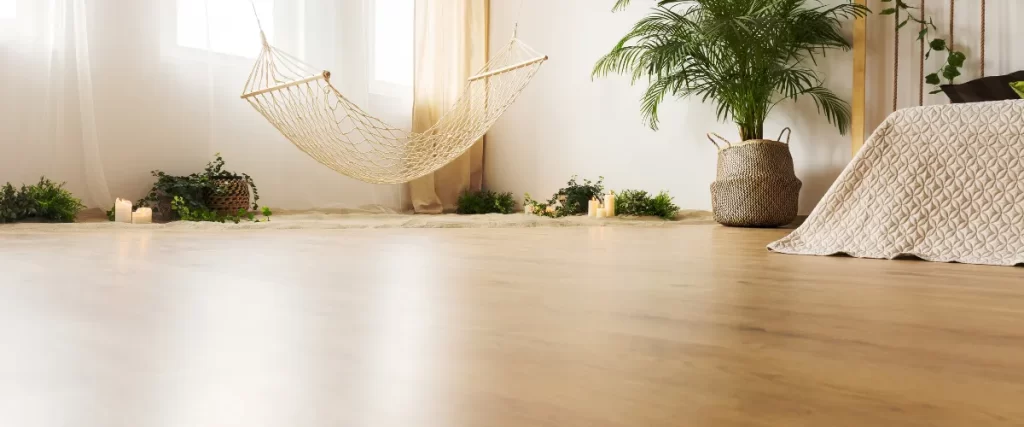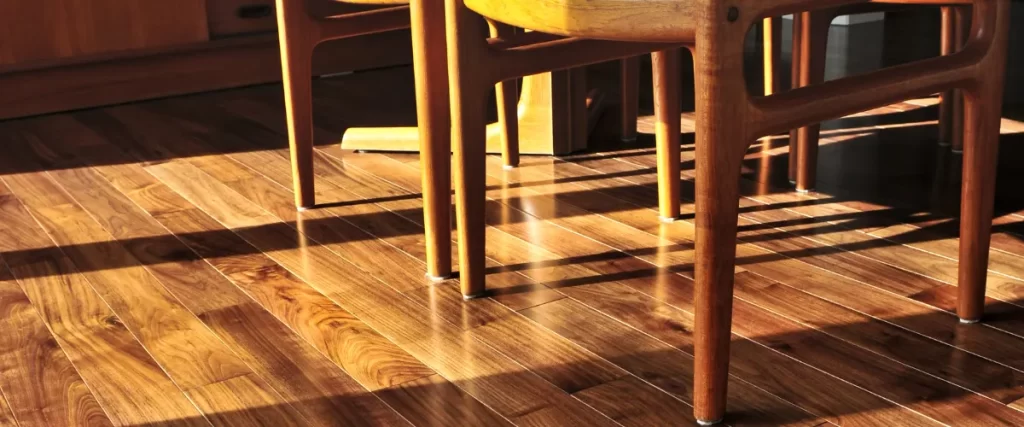Homes located near Lake Lanier and the Chattahoochee River enjoy a scenic environment and a unique lifestyle, but they also face environmental challenges that can affect indoor living spaces. One such challenge is the impact of moisture and fluctuating humidity levels on hardwood floors.
In this comprehensive guide, we’ll explore the best hardwood flooring choices for homes in these waterfront areas, discuss factors to consider when selecting flooring, and provide practical tips to ensure your floors remain beautiful and durable despite the local climate.

Understanding the Local Environment
Homes near Lake Lanier and the Chattahoochee River are often exposed to higher humidity and occasional moisture intrusion due to their proximity to water. These environmental conditions can accelerate wear on hardwood floors if the wrong materials or finishes are used.
Key Environmental Factors
- High Humidity:
Waterfront properties tend to have higher ambient humidity, which can cause hardwood floors to expand and contract, potentially leading to warping or gaps over time. - Moisture Exposure:
Proximity to bodies of water increases the risk of moisture penetration, either from outdoor humidity or indoor condensation. This can lead to mold, mildew, and other moisture-related issues if not properly managed. - Temperature Fluctuations:
Seasonal changes, especially in regions with significant temperature differences between summer and winter, can stress hardwood floors. Rapid temperature shifts may cause wood to dry out or absorb too much moisture.
Given these challenges, selecting hardwood flooring that is resilient and suitable for such conditions is crucial. The right choice can provide both aesthetic appeal and long-term performance.
Factors to Consider When Choosing Hardwood Flooring
Before exploring specific hardwood options, it’s important to consider several factors that will influence the longevity and performance of your flooring near water-rich environments.
Durability and Moisture Resistance
- Stability:
Choose hardwood that is known for its dimensional stability—meaning it resists expanding and contracting under varying humidity levels. - Moisture Resistance:
Flooring with natural moisture resistance or pre-treated with moisture-resistant finishes can help combat the effects of high humidity and occasional dampness.
Aesthetic Appeal and Authenticity
- Color and Grain:
The natural beauty of hardwood is often defined by its grain, color, and texture. Consider options that complement the overall design of your home. - Historical vs. Modern:
Some homeowners prefer classic hardwood options that reflect traditional styles, while others might opt for contemporary looks with more uniform finishes.
Environmental Impact and Sustainability
- Sustainable Sourcing:
Look for hardwood that is responsibly harvested or certified by organizations such as the Forest Stewardship Council (FSC). Sustainable choices not only protect natural resources but also enhance the value of your home. - Low-VOC Finishes:
Finishes that emit low levels of volatile organic compounds (VOCs) contribute to healthier indoor air quality—a significant consideration for families.
Installation and Maintenance
- Ease of Installation:
Some hardwood types are easier to install, whether via nail-down, glue-down, or floating methods. Professional installation might be required for more complex or exotic species. - Maintenance Requirements:
Consider the level of upkeep needed to maintain the floor’s appearance and durability. Floors that require less frequent refinishing or are easier to clean can save time and money over the years.
Top Hardwood Flooring Options for Waterfront Homes
Based on the environmental challenges and practical considerations, here are some of the best hardwood flooring options for homes near Lake Lanier and the Chattahoochee River.
1. Engineered Hardwood
Engineered hardwood is an excellent choice for environments with high humidity. It consists of a top veneer of real wood over multiple layers of plywood or high-density fiberboard (HDF), which offers greater stability than solid hardwood.
Benefits:
- Dimensional Stability:
Engineered hardwood is less prone to warping and cupping because of its multi-layer construction. - Versatility:
Available in a variety of wood species, finishes, and plank sizes, it can mimic the look of traditional hardwood while offering improved performance. - Ease of Installation:
Can be installed as a floating floor or glued down, making it adaptable to different subfloor conditions.
Considerations:
- Cost:
Often more affordable than solid hardwood while still providing a high-end look. - Resale Value:
Maintains a strong market appeal and can be refinished to extend its lifespan.
2. Solid Hardwood with Advanced Finishes
Solid hardwood flooring offers a timeless look and authentic warmth, but it must be carefully selected and finished to handle high-moisture environments.
Benefits:
- Natural Beauty:
Offers the authentic look and feel of natural wood, which many homeowners appreciate. - Refinishing Options:
Solid hardwood can be sanded and refinished multiple times, allowing for updates over its lifetime. - Customizable Finishes:
When paired with advanced, moisture-resistant finishes, solid hardwood can perform well in humid climates.
Considerations:
- Susceptibility to Moisture:
Without proper care and high-quality finishes, solid hardwood can warp or cup under high humidity. - Installation:
Best installed in areas with controlled humidity or with underfloor moisture barriers.

3. Bamboo Flooring
Bamboo flooring, technically a grass, is a sustainable and eco-friendly option that has gained popularity as a hardwood alternative. Strand-woven bamboo, in particular, is known for its exceptional hardness and durability.
Benefits:
- Sustainability:
Bamboo is a rapidly renewable resource, making it an environmentally friendly choice. - Durability:
Strand-woven bamboo is harder than many traditional hardwoods, offering excellent resistance to scratches and dents. - Moisture Resistance:
With proper treatment, bamboo can perform well in humid conditions, although it may not be as dimensionally stable as engineered hardwood.
Considerations:
- Finish Quality:
The performance of bamboo flooring depends heavily on the quality of the finish applied. Look for UV-cured or water-resistant finishes. - Environmental Sensitivity:
While bamboo is naturally moisture resistant, excessive moisture can still cause issues. Proper acclimation and installation are crucial.
4. Reclaimed Hardwood
For homeowners who value sustainability and historical authenticity, reclaimed hardwood can be an ideal choice. Sourced from old buildings, barns, or other structures, reclaimed wood carries a unique character and history.
Benefits:
- Unique Aesthetic:
Reclaimed wood often has a distinctive patina, grain pattern, and color variations that add character and charm. - Environmental Benefits:
Using reclaimed wood reduces waste and supports sustainable practices by repurposing existing materials. - Durability:
Many reclaimed woods are of high quality, having stood the test of time in previous applications.
Considerations:
- Consistency:
Reclaimed wood can vary in size, color, and condition, which may present challenges in achieving a uniform look. - Cost:
Depending on availability and quality, reclaimed hardwood can be more expensive than new engineered hardwood. - Preparation:
Proper cleaning, sanding, and finishing are required to restore reclaimed wood to its full potential.
Comparison of Hardwood Flooring Options
| Option | Key Benefits | Best For |
| Engineered Hardwood | High dimensional stability; versatile installation | Homes with high humidity; areas with subfloor challenges |
| Solid Hardwood | Authentic look; refinishing potential | Traditional aesthetics; areas with controlled moisture |
| Bamboo Flooring | Sustainable; very hard and durable | Eco-conscious homeowners; high-traffic areas |
| Reclaimed Hardwood | Unique character; environmentally friendly | Historic renovations; adding character and sustainability |
Installation Tips and Maintenance
Proper installation and ongoing maintenance are crucial to ensuring that your hardwood floors withstand the challenges posed by high humidity and seasonal changes near Lake Lanier and the Chattahoochee River.
Installation Tips
- Acclimation:
Allow hardwood flooring to acclimate to your home’s environment for at least 72 hours before installation. This helps reduce expansion or contraction after installation. - Moisture Barriers:
Use underlayment or moisture barriers during installation, especially on concrete subfloors, to prevent moisture from reaching the hardwood. - Professional Installation:
Consider hiring experienced installers who understand the nuances of working in high-humidity environments. Their expertise can ensure that the floor is properly installed with minimal issues.
Maintenance Tips
- Regular Cleaning:
Sweep or vacuum regularly to remove dust and debris that can scratch the surface. Use cleaning products recommended for hardwood floors. - Humidity Control:
Use dehumidifiers and maintain indoor humidity levels between 30% and 50% to minimize wood movement. - Refinishing:
Periodically check the finish on your hardwood floors. Refinishing every 5-10 years can help restore protective barriers and keep the floor looking fresh. - Prompt Repairs:
Address any signs of warping, cupping, or moisture damage immediately to prevent further deterioration.

Frequently Asked Questions
Q: What is the ideal indoor humidity level for hardwood floors?
A: Keeping indoor humidity between 30% and 50% is optimal for preventing expansion, contraction, and warping of hardwood floors.
Q: How do I choose between engineered and solid hardwood?
A: Engineered hardwood offers better stability in high-humidity areas, while solid hardwood provides a more traditional look but may require stricter humidity control.
Q: Is bamboo flooring suitable for waterfront homes?
A: Yes, when properly treated and installed, bamboo flooring is a sustainable and durable option, though it may require extra care in very high humidity.
Q: What are the benefits of using reclaimed hardwood?
A: Reclaimed hardwood offers unique character and sustainability benefits, though it may require more preparation and can be more variable in appearance.
Q: How can I prevent my hardwood floors from warping near high-humidity areas?
A: Proper acclimation, installation of moisture barriers, and maintaining stable indoor humidity levels are key steps to preventing warping.
Q: How often should hardwood floors be refinished?
A: Depending on usage and environmental conditions, refinishing every 5-10 years is generally recommended.
Best Hardwood Flooring Manufacturers
Choosing the right hardwood flooring manufacturer ensures quality, durability, and style for your home’s flooring needs.
- Bruce Hardwood Flooring: Renowned for affordability and durability, Bruce offers a wide range of traditional and modern styles.
- Mohawk Industries: Offers premium hardwood options with advanced technologies focusing on style, sustainability, and moisture resistance.
- Shaw Floors: Known for innovative finishes, Shaw provides high-quality, sustainable hardwood flooring options for various budgets.
- Mullican Flooring: Specializes in eco-friendly production and offers a variety of hardwood flooring types with precision milling.
- Armstrong Flooring: A trusted name offering durable and stylish hardwood floors with a focus on engineered wood products.

Why Choose Our Team
Our team has been delivering exceptional hardwood flooring services for years, ensuring professional results. Work with the best and save money long-term. Contact us at to get your hardwood floor refinishing project started.
